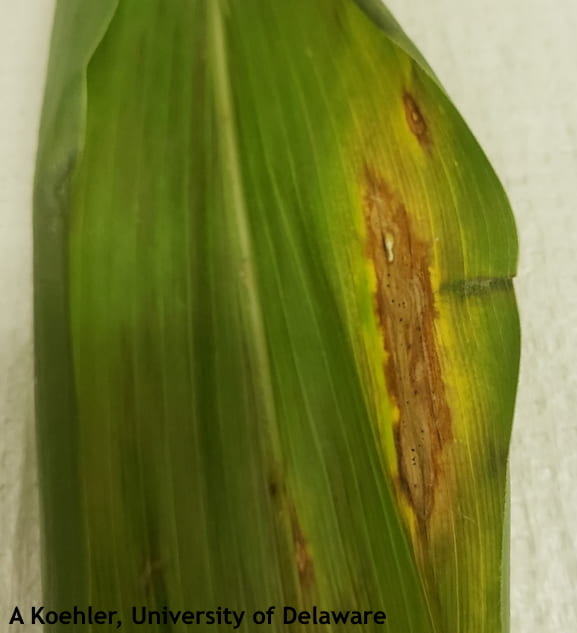Alyssa Koehler, Extension Field Crops Pathologist; akoehler@udel.edu
Corn
Corn in the area is at VT to R3 with some scattered reports of Grey Leaf Spot. I have found a few cases of Diplodia Leaf Streak that can look similar to other corn lesions, like those from Northern Corn Leaf Blight. Diplodia leaf streak has oval to elongated, brown lesions with yellow margins. Inside of the lesions, you will see black fungal fruiting structures called pycnidia; these are not present in lesions from Northern Corn Leaf Blight.
Figure 1. Diplodia Leaf Streak, note black dots (pycnidia) at the center of the lesion
Soybean
Overall disease pressure has been low in soybeans. There have been a few fields of double-crop beans with emergence issues. Pythium in the roots, as well as lesions from Fusarium on the cotyledons have been present on diseased seedlings. Downy Mildew has been observed, but it is not typically a disease that impacts yield. We have also seen a few cases of stem rot caused by the fungal Diaporthe/Phomopsis complex. Diaporthe spp. can cause stem canker, pod and stem blight, and late season Phomopsis seed decay. In the case of stem canker, a red-brown canker begins at a node and can extend to several nodes on the stem, sometimes girdling the stem resulting in plant death. Leaves may have interveinal necrosis and remain attached to the petioles even once they are dead and dried. Pod and Stem blight is usually most visible from R6 to R8 where black specks form in straight lines on mature stems. These raised, black dots are fungal structures, called pycnidia that house the spores of the pathogen. Warm, humid weather can favor the development of pod and stem blight. The Crop Protection Network publication Scouting for Soybean Stem Diseases provides some nice images and a helpful diagram for sorting through symptoms of soybean disease https://crop-protection-network.s3.amazonaws.com/publications/cpn-1002-scouting-for-soybean-stem-diseases.pdf

